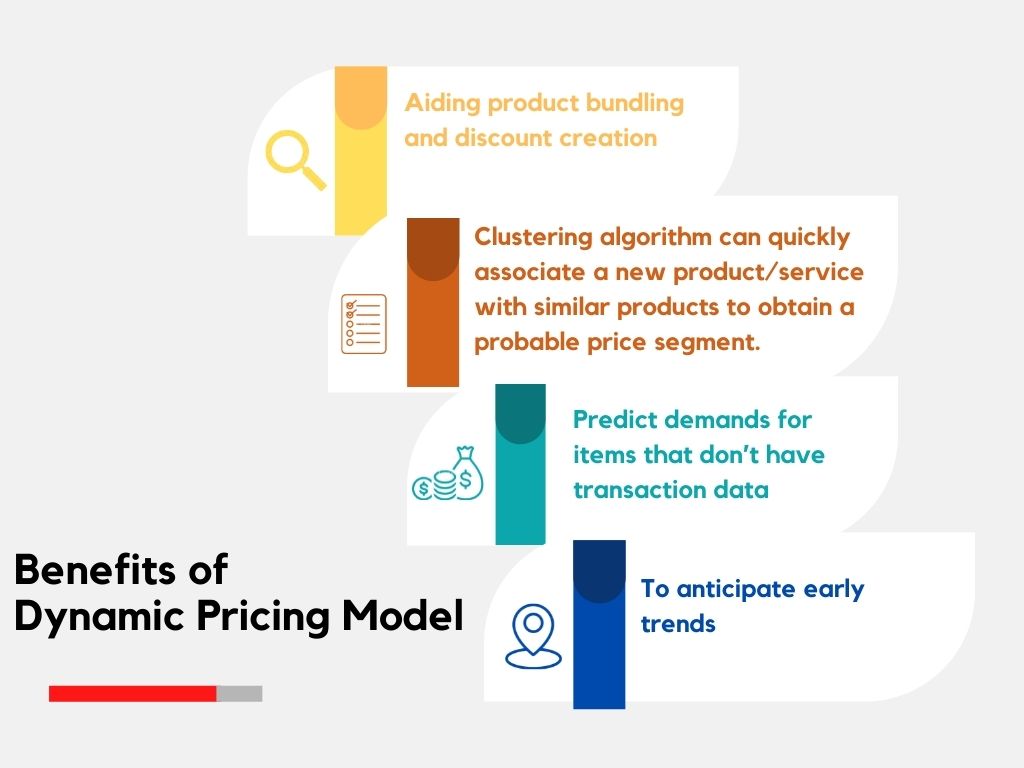Developing Machine Learning Models for Dynamic Pricing
We previously talked about price optimization and dynamic pricing. Today, we are going to look at using developing machine learning (Ml) in dynamic pricing models.
With artificial intelligence (AI) technology now going mainstream, dynamic pricing is something that even small retailers and e-commerce players can now use to compete in the retail market.
E-commerce activity generates too much data for a team of humans to handle. ML solves this issue because it can process data faster and without stopping. A well-designed ML algorithm even learns and makes pricing suggestions in real-time.
This allows retailers to set product prices based on supply and demand, also known as dynamic pricing. To put it plainly, ML is valuable because it automates a task that is almost impossible for humans to do manually.
Express Analytics puts the voice of the customer at the heart of the business. Want to learn more about the dynamic pricing model? Fill up this short form and our experts will touch base with you.
But before that, the retailer needs to not only know his inventory but also what data is incoming. ML-powered software gets information from data to throw up dynamic pricing solutions.
ML works on a simple philosophy – the larger the data sets, the better the learning process, and the better the outcome. Over time, ML-based software only improves in performance.
Analysts can take other factors into account for dynamic pricing. For example, an analyst could choose weather, demand, operating costs of the company, competition, the minimum price, the best price, etc.
In the end, for a competitive pricing strategy, ML solutions can repeatedly scrape the web to collect important information about prices set up by competitors for similar products, what consumers’ opinions were about products, as well as the pricing history over the last number of days/weeks.
So, when ML is used, what difference does it make in dynamic pricing? AI and ML permit wider data analysis, which results in better-off resolution functionality.
How to Develop a General Dynamic Pricing Model?
The most important considerable aspect is the level of granularity you are aiming for. For example, are you looking at a single customer level or an entire segment?
Another crucial factor is defining strategic goals that align with business goals. Profit maximizing is obvious, right? But you could also choose goals for getting new customers or satisfying old customer satisfaction metrics.
The ML-based dynamic pricing model can then be developed once the answers to the above points come in. The model will predict whether someone will make a purchase at a price best optimized at that moment in time.
The models can be used either using the Generalized Linear Models (GLMs), or the Deep Learning methods.
Transform Your Business using Express Analytics’ Machine Learning Solutions
Benefits of Dynamic Pricing Model
- Aiding product bundling and discount creation
- The clustering algorithm can quickly associate a new product/service with similar products to obtain a probable price segment.
- Predict demands for items that don’t have transaction data
- To anticipate early trends

Businesses that do deploy ML-based models for dynamic pricing tend to increase their margins by 10% and more, and sales also increase by up to 10%.
Adjusting prices in real-time through the pricing model does that for your business.
Dynamic Pricing Strategy: Common Mistakes to Avoid
A successful implementation of a dynamic pricing strategy needs careful planning to avoid common mistakes.
In this section, let’s explore the most frequently seen challenges faced by organizations when using dynamic pricing strategies:
Neglecting user experience:
Marketing conditions and prices of competitors are important in terms of adjusting product prices.
In addition, don’t ignore your customers because, in the end, they have the right to make product purchasing decisions.
Also, ensure that your clients find price modifications fair and reasonable.
Frequently changing the price:
If customers find that you are changing prices frequently, they can become frustrated, resulting in a loss of sales.
Sometimes, as per market demands, you might change prices to manage the balance between profits and price, but if this process repeats again and again, it ends up with unhappy customers.
Lack of up-to-date data or reliable data:
Dynamic pricing is purely dependent on real-time data to create the perfect pricing strategy.
Without reliable or accurate data, your pricing strategy produces profitless results. Ensure that you have an accurate system to gather and inspect data.
Improper segmentation of target audiences:
If your business is providing different products or the same basic products with numerous variations, you’re expected to attract a wide range of audiences, and each segment is drawn to various products for extremely different reasons.
It’s not a systematic approach to offering customized experiences that every audience wants.
By considering this factor, you have to set up prices and identify the natural segmentation to find your target audience when you’re planning for marketing and sales concepts.
Risks of Dynamic Pricing Strategy
Let’s explore some potential algorithmic pricing risks:
Customer loyalty reduces:
The major problem with automated pricing is customers leaving your brand. This occurs in two ways:
- Market-oriented pricing
- Repeated and unforeseeable price changes
To make customers stay with the brands, they should stick to the brand principles by bringing price modifications in line:
- Give a valid reason for the hike in prices
- Reposition their marketing according to price changes
Unmanageable pricing:
Before allocating a price to any product, there should be a team to approve suggestions related to pricing, and test regularly to ensure pricing doesn’t make any difference in their pricing decisions.
However, once a large company implements dynamic pricing, there should be a team to monitor and control the algorithm.
One of the major causes is that computers can’t consider the human psychology or mindset of pricing.
Once the prices reduce to the 1s and 0s, the computer can discover the “best” price.
Computers should consider a wide range of factors to discover the suitable price, but in some cases, a human being declines the pricing suggestions by saying “no”.
Transparency and Complexity:
Incorporating a personalized dynamic pricing strategy in business is not easy and needs complicated algorithms and data analysis.
Keeping transparency in pricing concepts becomes important as customers start doubting if they don’t find clarity or identify the reasons behind price hikes.
Retail businesses must communicate their pricing approaches properly to maintain their customers’ trust.
Audience privacy concerns:
The dynamic pricing algorithms depend on data gathering and inspection to know audience behavior and allocate prices.
Moreover, this leads to privacy concerns, as audiences may not feel comfortable knowing that their confidential data is being used to decide prices.
Both e-commerce and retailers must adhere to data protection laws and maintain transparency to address issues related to privacy.
Dynamic Pricing in the Retail Industry: Dos
Focus more on the final price:
Along with the listed price, customers also look at the total cost, inclusive of shipping fees, taxes, and extra charges.
Retail businesses must position their dynamic pricing approach with the selected value proposition, making intelligent decisions related to customized offers, shipping choices, and promotions.
Track and enhance:
Dynamic pricing needs a test and learning concept. Inspecting the effect of price modifications and making adjustments according to real-time data is important.
Communication between merchants and pricing specialists can result in valuable insights.
Develop a strategy carefully:
Understand your present position in the competitive environment and the consumer’s point of view concerning your brand.
Prepare a step-by-step approach to developing data, tools, talent, and infrastructure.
Looking to Scale Your Retail Operations using AI & ML?
Dynamic Pricing in Retail Industry: Don’ts
Don’t confuse customers:
Frequent fluctuations in prices can confuse customers, forcing them to look for alternatives.
Pricing offers should be consistent across channels and devices to prevent confusion among customers.
Don’t alter prices unreasonably:
Price changes should have genuine triggers, including seasonal alterations or forthcoming product introductions.
Stop altering prices when competitors’ prices or costs are the same. Communicate price deductions to customers to increase their effect.
Don’t depend on bad data:
Incorrect or generalized entries can end up with inaccurate price recommendations and lead to margin losses.
Clean up pricing entries regularly and enhance accuracy in price attribution for the best price recommendations.
How Does Dynamic Pricing Use Machine Learning?
Dynamic pricing uses ML in numerous ways to boost pricing strategies.
Listed below are some use cases related to the same:
Demand prediction:
Machine learning can be used to look at past data and various other factors, such as the latest market trends, promotions, and seasonality to predict future demand for products.
Dynamic pricing automation:
ML can automate the process of dynamic pricing by regularly inspecting market data and fixing prices accordingly. This cannot take much time when compared to adjusting prices manually.
Inventory management:
By forecasting demand and fixing prices accordingly, businesses use ML to manage their inventory, minimizing holding costs and the possibility of overstocking or stockouts.
Express Analytics offers a wide range of services to customers. From Marketing mix analysis to RoI optimization.
Liked This Article?
Gain more insights, case studies, information on our product, customer data platform

